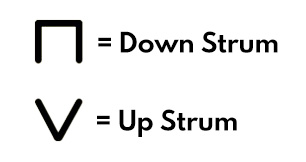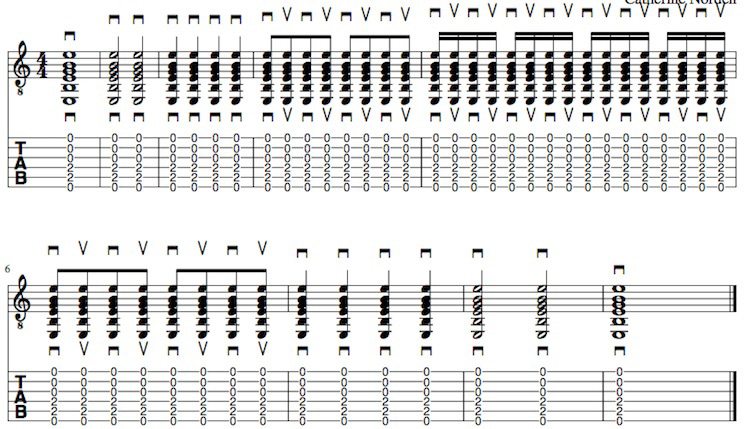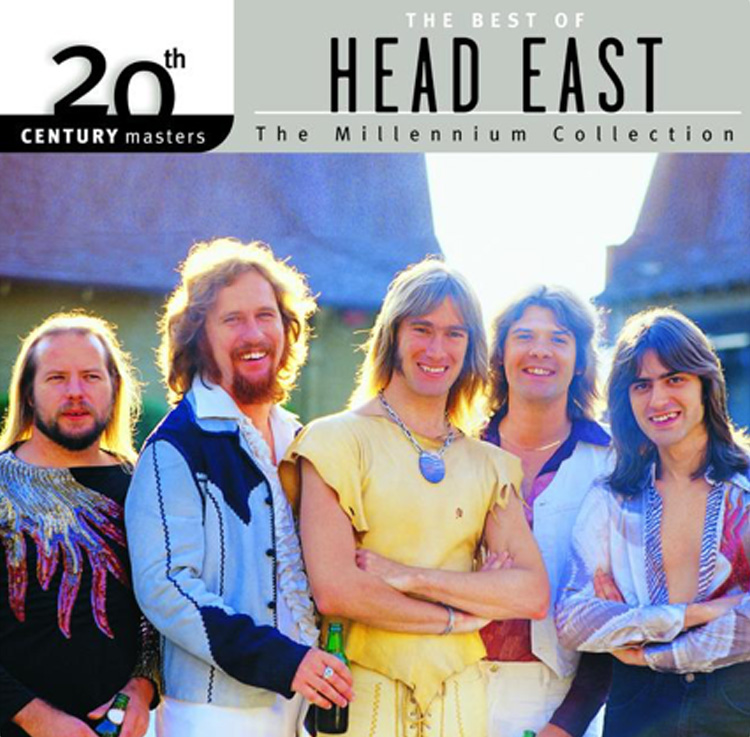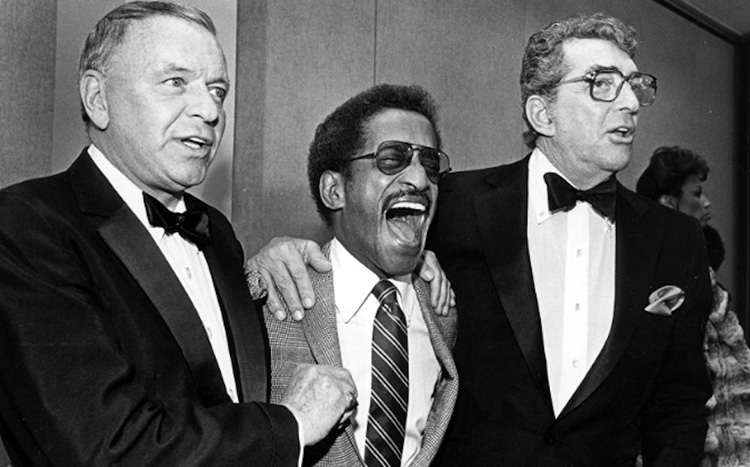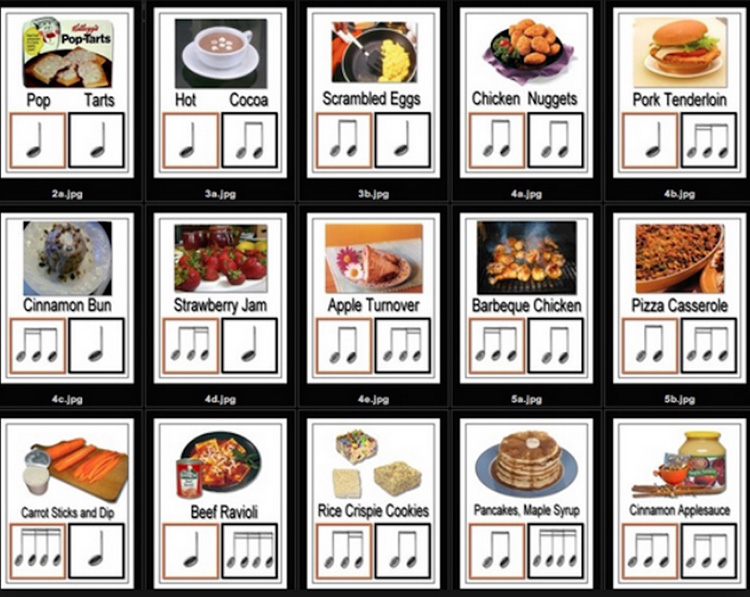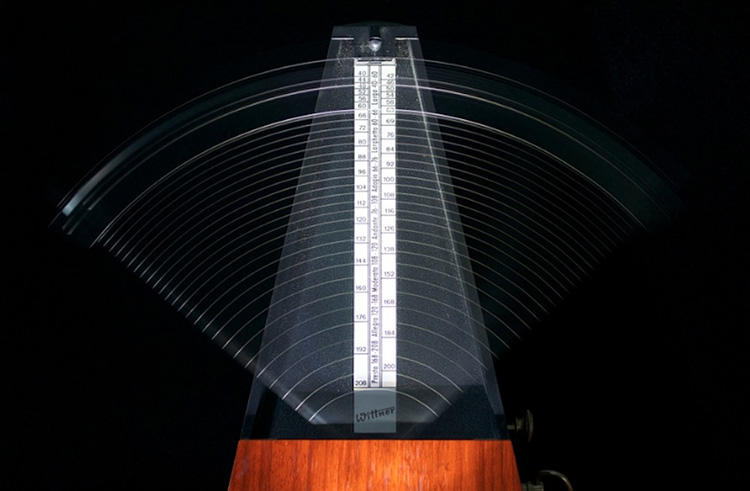Guitar Rhythm Exercises help us to fine-tune our rhythm skills. We’ve got a bunch of great ones for you, so let’s dive in!
Over 100,000 guitar-learners get our world-class guitar tips & tutorials sent straight to their inbox:
Click here to join them
Get our best guitar tips & videos
In this free lesson you will learn…
- 5 guitar rhythm exercises
- The fundamentals of rhythm in music
- How to practice rhythm without an instrument
- How to practice rhythm with an instrument
Get Ready To Get Rhythm!
Oh, we’re so glad you found us. Good rhythm makes all the difference in the world in making music enjoyable to play and listen to.
The number one complaint I hear from my students is that they have so much trouble getting through a song without having to stop and start over again.
With all the things that are difficult about learning to play guitar – making chords that sound decent, figuring out how to switch between chords, picking up a flatpick and strumming, maintaining decent posture to avoid injury – trying to keep steady rhythm on top of all of that can feel a little overwhelming.
When we have trouble maintaining steady rhythm, our songs don’t really sound good, even when we’re doing everything else correctly. So discouraging.
If this is you, though, cheer up! You’ve come to the right place to address this issue.
These guitar rhythm exercises are going to help you to get on the path of the rock-steady rhythm guitarist.
- The exercises in this lesson are designed for you to get in touch with your own sense of rhythm.
- We’ll use time-tested methods for you to develop your internal metronome and to work with an external metronome so that you can keep count without issue.
Rhythm is a skill every musician needs to have to get past the very beginning level on their instrument, so let’s get to it!
Some Basic Concepts about Time
Hey, skip forward if this is a big old boring review for you, but it’s crucial to understand these ideas about music and time in order to be able to play in rhythm, especially if you are playing with or for other people.
- I promise that it does not suck all the fun out of music to know the crucial point that music is a way of passing time in measured increments.
- Those increments are called counts or beats.
- The beats are what you feel happening in a song, regardless of whether there are drums, guitars, or even nothing.
- Missing beats or adding beats to a song can make it sound wrong, even when everything else you are doing is right. It’s basic but very non-negotiable.
The groups of beats, usually four, or three or six or nine. These groups are called measures.
If you are a progressive rock band like Yes, Tool, the Grateful Dead, Genesis, Mars Volta, Rush, and many others; then seven, eleven, thirteen, or fifteen might be time signatures that you will play with, but those are for a different day.
When we are counting in music, we are counting the beats in the measures.
Learn 12 EASY beginner chords with our popular guide


Where should we send it?
✅ Stop struggling. Start making music.
✅ Learn beginner-friendly versions of every chord.
This is our most popular guide and it will improve your chord ability quickly! 😎
Get your own personalised guitar-learning plan 🎸
Get a custom guitar-learning plan here: Click here for GuitarMetrics™
World-Class Guitar Courses 🌎
Learn from the world's best guitar educators: Click here for our guitar courses
Guitar Rhythm Exercises: Meter, Downbeat, and Counting
The idea of meter is knowing how many counts or beats are in a measure and how those beats are to be divided. More on that later.
The downbeat is simply the first beat in the measure – the “one”.
- When you are counting in music, you are constantly counting the number of beats in the measure, at least as a working definition.
- “One two three four” is the count-off for a song, where the agreement is reached how fast everybody playing the song will be counting.
- Counting in music is done a few different ways, mostly with the body.
Chuck Berry has the duck walk. Trey Anastasio of Phish bobs his head.
Angus Young of AC/DC marches around the stage. Dave Matthews does that interesting bob-and-weave thing.
Kristin Hersh waggles her head back and forth, and James Hetfield (ever the traditionalist) bangs his head.
All of those people are keeping time, counting with their bodies.
Guitar Rhythm Exercises: Keeping the Beat
No matter what specific rhythm you are playing on the guitar at any given time, you are always keeping the beat, or at least referring to the beat.
- Although the right note out of rhythm sounds like a mistake every time, you can play a terrible note or chord at the right time, in the right rhythm, and nobody will ever know.
- For this reason, rhythm is the first aspect of music that really demands a lot of practice, and here’s how we’re going to start our guitar rhythm exercises: with counting.
Counting in standard notation is guided by the appearance of notes. If you’d like a little primer on what those look like before continuing, here’s the rundown.
This exercise shows you how each of these shorter notes fit into the larger notes.
To begin playing it on the guitar, you’ll simply clap and count.
Here’s how:
This counting will come in handy in all guitar rhythm exercises.
First, clap and count. Clapping and counting is the best (if not the only) method of being sure that the math checks out on the rhythm that you want to play.
This is also the best exercise for seeing how all the beats fit together in a measure.
Clap and count this exercise slowly, keeping the 1 + 2 + 3 + 4 + count steady while you tap your foot on 1 2 3 4.
In the first measure, you’re clapping on beat one.
In the second measure, you’re clapping on beats one and three.
In the third measure, you’re clapping on each beat. In the fourth measure, you’re clapping twice per beat, and in the fifth measure, you clap four times per beat.
The counting stays the same, but the clapping gets more frequent.
Got it? Good! Let’s put it on the guitar.
You’ll play the same rhythm, only now you’re strumming.
When you get to the eighth notes, you’re strumming down on the numbers and up in between, and for the sixteenth notes, you’re strumming down on 1, up on e, down on +, and up on a.
The symbols for down and up strums look like this.
Now, tapping your foot to the beat and counting slowly, try the same rhythm exercise while strumming the E minor chord.
If keeping a steady beat has got you a little confused, don’t worry! Check out this lesson for some assistance before moving on: How to Play in Time
Pro-Tip: Try guitar rhythm exercises at different tempos, or speeds. You can find free metronome apps for your phone; the number you’re setting is the number of beats per minute. Slow is about 60, medium might be 90, and fast might be 120, although you’re encouraged to play at any tempo you like as long as you can keep the beat steady and controlled.
Guitar Rhythm Exercises: Straight Versus Swing Rhythm
Now that we’ve got some basic rhythm happening, it’s time to explore the two basic flavours of rhythm: straight (simple meter) and swing (compound meter) through guitar rhythm exercises.
- When you divided the beat in the exercise above, you divided one quarter note into two eighth notes, right in half, with even down and up strums.
- That’s straight rhythm, or ‘simple meter’, where the beat is divided evenly in two.
Swing rhythm or ‘compound meter’ is where you divide the beat into three, or triplets.
Instead of counting 1 + 2 + 3 + 4 +, you count 1 + a 2 + a 3 + a 4 + a.
Try it! Swing rhythm feels less like a march and more like a gallop.
Strumming in swing rhythm, mathematically speaking, is strumming down for ⅔ of the beat and strumming up for the last ⅓. The basic tempo and beat stay the same; the difference is in how you divide the beat.
It’s a good idea to get this concept mastered in your ear and in your strumming hand.
That way, when you go to play a song, if it swings, you can swing too!
Here is a simple four-measure exercise that you can repeat to teach yourself how to play straight eighth notes and how to swing with triplets. Strum this one with the C major chord.
The trick is to keep the beat at the same tempo so you really notice how the feel changes when you switch between straight and swung rhythm. You’ve got to know how to swing, and now you do!
Guitar Rhythm Exercises: Fundamental Combinations
It is very easy, when learning your first songs on the guitar, to get hung up on the question of “What’s the strumming pattern?”
- There’s nothing wrong with that, except that simply copying a strumming pattern that’s given to you doesn’t really help you develop skill at rhythm guitar very efficiently.
- Rhythms exist in patterns, yes, but they also exist in interesting combinations.
- With that, there is no better way to learn to stay in time while subdividing the beat than to make up your own rhythm exercises.
For those of you with a prior musical history in band, orchestra, private instrument lessons (or a children’s choir in a community, church, or school), some of this will sound familiar.
Tying rhythms to short phrases and using spoken syllables to associate with rhythmic notation is a common method all music educators use to get children to start understanding and internalizing rhythm.
One such music educator loved this technique so much that she started associating each rhythmic phrase with food. Check it out:
Sooner or later, all music metaphors wind up being about food! This interesting and delicious set of rhythms is what you will use to make your own set of guitar rhythm exercises.
- Your first set of guitar rhythm exercises should be done without a guitar.
- While tapping your foot to the quarter note beat, repeat each rhythm, one at a time, over and over. Just say the words, tap your foot, and get used to how the words fit into the beat.
- Then take your guitar rhythm exercises to the guitar!
Strum each rhythm while saying the phrase to yourself and tapping your foot to the beat.
It may take a lot of repetition, but that is the nature of the rhythm game. It takes a while for your muscles to be able to consistently execute a rhythm that you can hear in your head and understand.
Once you’ve mastered these guitar rhythm exercises individually, start to mix and match! This is where it gets interesting, creative, and fun. Take two rhythms and string them together, and repeat.
Download our lead guitar cheat-sheet to make things easier
It's hard to understand which scales work with which keys.
So we created a cheat-sheet! A key and scale-finder that you can use again and again.
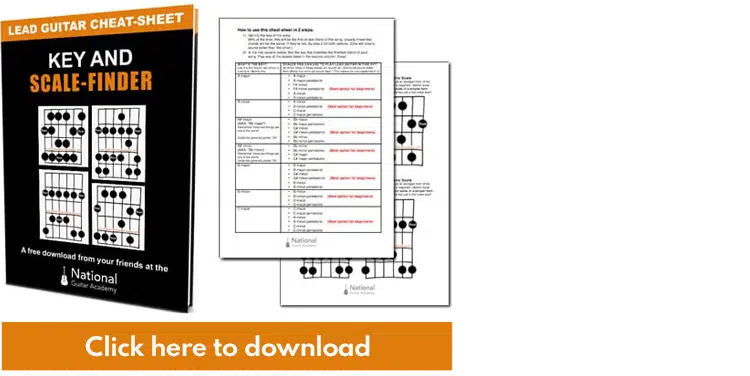
Get your personalised guitar-learning plan 🎸
Get a custom guitar-learning plan here: Click here for GuitarMetrics™
World-Class Guitar Courses 🌎
Learn from the world's best guitar educators: Click here for our guitar courses
More Metronome! Said No One, Ever.
Oh, the poor maligned metronome.
- Constantly accused of lying and perpetually in danger of being splintered into pieces on the floor by hordes of frustrated musicians, at least before they became phone apps.
- At some point in your career, your metronome is going to turn your entire musical repertoire into a series of guitar rhythm exercises.
- Once you learn to wield the awesome power of the metronome, it will become your trusted ally!
The metronome app I use on my iPhone is called Metrotimer, and it is free.
There are plenty of metronome apps available, some with a whole package of stuff like tuners. There are fun and cool apps that provide you with great beats like Drumgenius.
At the beginning however, it’s best to keep it simple while you are getting the hang of these basic guitar rhythm exercises,
Here is your first metronome exercise, a four-measure rhythm warmup I have adapted from the warm-up exercises used by the snare drum line of the drum and bugle corps I marched in when I was a wayward teenager.
Strum this with the D major chord. You can pick any chord you like for these guitar rhythm exercises, and even mix and match them if you like a little bit more of a challenge.
Set your metronome at a workable tempo that allows you to count and strum at the same time. It will help you keep track of the beat, provided you listen to it!
- The metronome will be clicking in between the beat for the back half of the exercise.
- Those consecutive upward strums can make you feel a bit like you’re going to hit yourself in the forehead.
- To overcome that feeling, make sure that your strumming arm is dropping in between the up strums.
Keeping the constant down-up-down-up strumming motion helps you to fit those up strums exactly where they belong, in between the beats.
Play this one over and over until you achieve total synergy with the metronome!
Pro-Tip: Metronomes can be used in different ways than just tapping out quarter notes, although that is the best way to use them for guitar rhythm exercises when you are just starting out.
You can use them to tap only on beats 1 and 3, or beats 2 and 4.
Check out these creative metronome exercises!
Going Further and Deeper into Guitar Rhythm Exercises
Now that you’ve gotten yourself some guitar rhythm exercises to help you maintain a steady beat and play some different rhythms within a framework, it will be easier to follow strumming patterns and to develop your own grooves for the songs you love to play.
Make guitar rhythm exercises a part of your daily practice with this excellent book:
Recommended resources
- 3 Easy Ways To Play The A Chord On Guitar
- Am Guitar Chord For Beginners
- Guitar Tabs For Beginners: 20 Easy Songs That Sound Great
- What’s The Best Beginner Guitar?
- 14 Easy Guitar Chords For Beginners
What Type of Guitarist Are You?
Take our 60-second quiz & get your results: Take The Quiz
Join the world's best online guitar school 🌎
- Get your own personalised guitar learning plan (customised just for YOU).
- World-class online guitar courses. Learn at your own pace.
- Community Campus & Learning Forum - A friendly community! Connect with our team & students. 😊
- Beginner Song library with chordsheets, tabs and tips. (Songs suitable for all levels!)
- Regular live streams, seminars and Q&A sessions - Learn from world-class guitar educators. Get all your questions answered!
Click here to learn more about National Guitar Academy membership 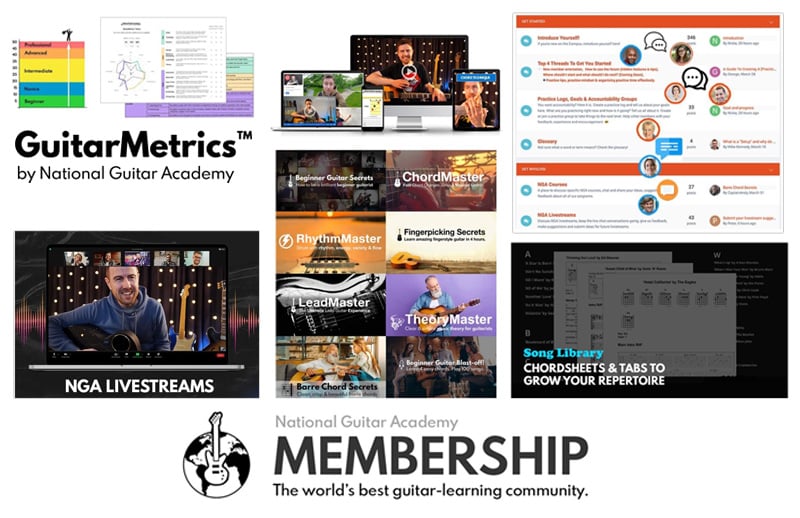
Cool Guitar T-shirts 😎
Look cooler! Check out our merch: Click here to see our merch store
Want free guitar tips and video lessons delivered to your inbox?
Join over 100,000 guitar-learners and subscribe to our guitar-tips-by-email service. (It's free.)
We'll send you a series of lessons that will move you to the next level of your guitar journey.
Learn how everything fits together quickly, easily and effectively. We share ninja tips (for instant fun!) but also timeless fundamentals that will deepen your understanding.


Get our best guitar tips & videos
Popular Lessons
How To Learn Guitar: An 11-Step Programme For Beginners
How To Choose The Perfect Beginner Guitar
More Cool Guitar Stuff
Learn about National Guitar Academy: About Us
Join us on Facebook for daily guitar tips.
Listen to our Learn Guitar Podcast for rapid guitar progress.
Check out our free chord lessons.









